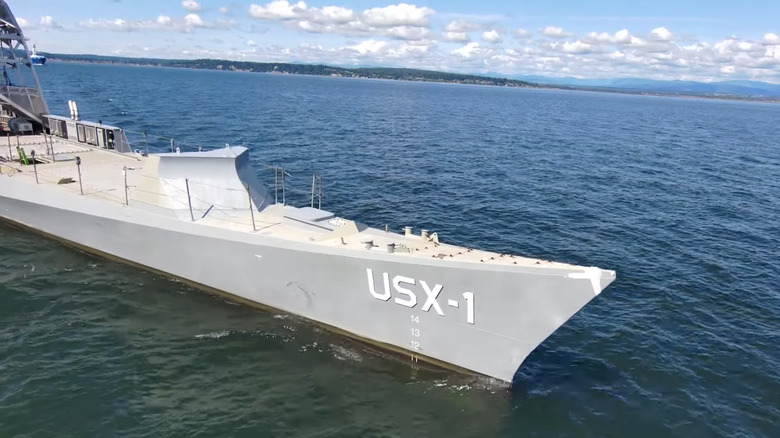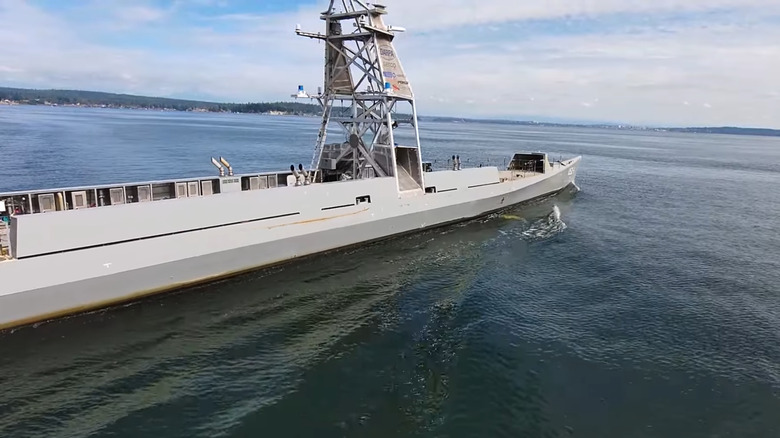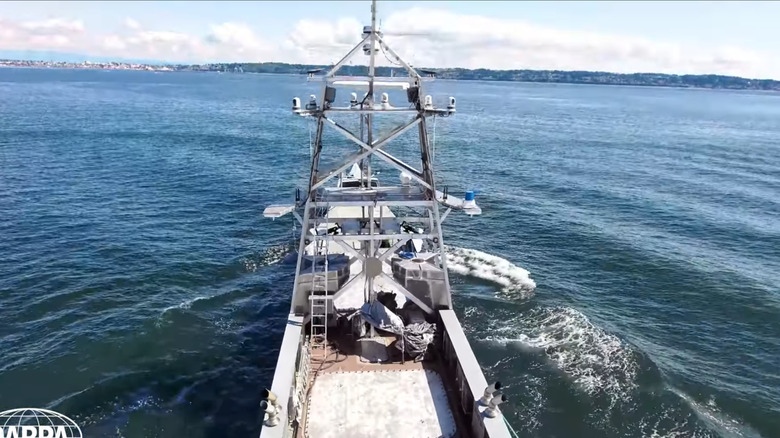What To Know About The Release Of The US' First Autonomous Warship
DARPA has officially christened the USX-1 Defiant, a 180-foot unmanned surface vessel that could change naval surface warfare forever. It has been developed under the agency's No Manning Required Ship (NOMARS) program, and unlike optionally crewed platforms, Defiant was built from bow to stern to be unmanned. At 42-feet tall and weighing in at nearly 265 tons, it has a top speed of 20 knots. More importantly, it's designed to operate at sea for up to a year without needing to make port. DARPA has even tested at-sea refueling systems to extend its endurance.
The vessel represents a major shift for the U.S. Navy. Its simplified hull allows for cheaper, faster production and maintenance in facilities that normally handle yachts and tugboats. This means that one of the largest navies in the world could scale a fleet of unmanned ships much faster than traditional warships. DARPA Director Stephen Winchell described Defiant as a "cost-effective, survivable" platform capable of multiplying combat power while unlocking new industrial capacity.
Following final systems tests, Defiant will undergo an extended demonstration at sea before being handed off to the Navy's Unmanned Maritime Systems Program Office (PMS 406). It's an early sign of the Navy's transition toward a hybrid fleet of manned and unmanned vessels aimed at expanding capacity without the long timelines and high costs associated with conventional shipbuilding.
Why the Navy wants autonomous warships now
The Navy is pursuing unmanned platforms to address two urgent challenges: cost and capacity. Building and crewing large vessels is increasingly expensive, and they take years to enter service. By contrast, Defiant's design focuses on rapid production using simpler shipyard infrastructure. That could help the Navy field more ships, faster.
Unmanned systems also keep sailors out of harm's way, with many U.S. destroyers requiring hundreds of crew members. The Indo-Pacific region, with expected fast-paced and unpredictable future conflicts, can use robotic vessels to conduct survey, defend, and support without risking sailors. Navy leaders, together with congressmembers, support the development of these unmanned ships.
By dispersing capability across smaller, cheaper robotic ships, the Navy could reduce its reliance on a handful of expensive capital vessels. This model makes the fleet harder to target and potentially more adaptable in combat scenarios. Congress has backed the approach, appropriating billions for unmanned surface vessels. That funding shows growing support for programs like NOMARS, which aim to field real platforms rather than just prototypes.
What comes next for the Defiant-class
Defiant's upcoming at-sea trials will test reliability and endurance under real-world conditions. The Navy has already released requests for information on medium USVs, signaling interest in vessels under 200 feet long. Defiant's specifications place it squarely within that category.
Future missions could see Defiant integrated into carrier or expeditionary strike groups, where it would serve an intelligence role or engage in strikes. The Navy's former Chief of Naval Operations outlined plans to have proven robotic systems integrated into all deploying strike groups by 2027. While leadership has since shifted, incoming officials have retained priority status for this mission.
The christening of Defiant doesn't mean the Navy has a fleet of robot warships, but it does mark the beginning of a transition in that direction. With DARPA's technology now moving into the Navy's program office, Defiant could serve as the blueprint for how the U.S. Navy fields its first generation of truly autonomous warships.


